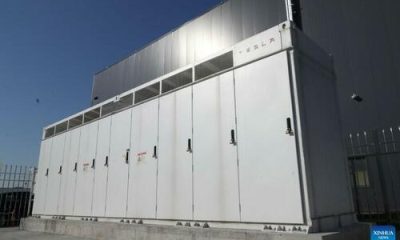Energy & Critical Metals
UC Irvine team creates long-lasting, cobalt-free, low-nickel lithium-ion batteries
In a discovery that could reduce or even eliminate the use of cobalt—which is often mined using child labor—in the batteries that power electric cars…

In a discovery that could reduce or even eliminate the use of cobalt—which is often mined using child labor—in the batteries that power electric cars and other products, scientists at the University of California, Irvine (UCI) have developed a long-lasting alternative made with nickel.
In a paper published in the journal Nature Energy, the researchers report using a complex concentrated doping strategy to eliminate cobalt in a commercial NMC-532 cathode.
The LiNi0.5Mn0.43Ti0.02Mg0.02Nb0.01Mo0.02O2 [HE-N50] cathode shows potential cost advantage with relatively high specific energy and significantly improved overall performance (~95% capacity retained after 1,000 cycles in pouch-type cells, 2.8–4.3 V vs graphite, at 1 C, 1.5 mA cm−2).
—Zhang et al.
Specific capacity and specific energy comparison of HE-N50, NMC-532 and NMC-811. All the cathodes are tested in half-cell (vs. Li metal), and the 2nd cycle at C/10 are plotted for calculating the specific capacity and specific energy. For the HE-N50 and NMC-532, the cutoff voltage is 2.7V-4.5V, and for the NMC-811 the cutoff voltage is 2.7V-4.4V. Zhang et al.
Until now, nickel wasn’t a practical substitute because large amounts of it were required to create lithium batteries, said Huolin Xin, the UCI professor of physics & astronomy whose team devised the method. Further, the metal’s cost keeps climbing.
To become an economically viable alternative to cobalt, nickel-based batteries needed to use as little nickel as possible.
We’re the first group to start going in a low-nickel direction. In a previous study by my group, we came up with a novel solution to fully eliminate cobalt. But that formulation still relied on a lot of nickel.
—Huolin Xin
To solve that problem, Xin’s team spent three years devising a process called complex concentrated doping that enabled the scientists to alter the key chemical formula in lithium-ion batteries. The doping process, Xin explained, eliminates the need for cobalt in commercial components critical for lithium-ion battery functioning and replaces it with nickel.
Doping also increases the efficiency of nickel—i.e., EV batteries would require less nickel to work. Electric vehicle companies are planning to take his team’s published results and replicate them, Xin said.
This work was primarily supported by the US Department of Energy (DOE) Office of Energy Efficiency and Renewable Energy under the award number DEEE0008444.
Resources
-
Zhang, R., Wang, C., Zou, P. et al. (2023) “Long-life lithium-ion batteries realized by low-Ni, Co-free cathode chemistry.” Nat Energy. doi: 10.1038/s41560-023-01267-y
lithium
cobalt
batteries
graphite
electric vehicle
renewable

Uranium Exploration Company Announces Additional Staking in the Athabasca Basin
Source: Streetwise Reports 12/22/2023
Skyharbour Resources Ltd. announced an update from its Canada-based Falcon Project along with additional…
Tesla Launches New Mega Factory Project In Shanghai, Designed To Manufacture 10,000 Megapacks Per Year
Tesla Launches New Mega Factory Project In Shanghai, Designed To Manufacture 10,000 Megapacks Per Year
Tesla has launched a new mega factory…
Giving thanks and taking stock after “a remarkable year”
An end-of-year thank you to our readers, industry colleagues and advertisers before Electric Autonomy breaks from publishing until Jan. 2
The post Giving…













